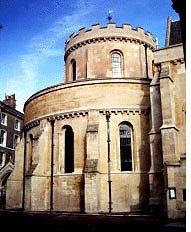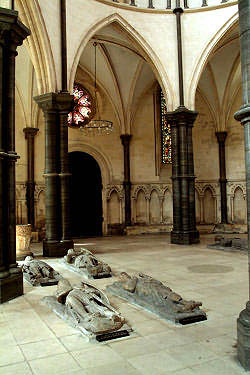London's Temple of the Warrior Monks
by Louise Simmons
Tucked down a small alleyway off London's famous Fleet Street, the legendary home of British journalism, is another legend, and one that most people don't even know is there. Although you'll have heard of it if you've been reading Dan Brown's bestseller, The Da Vinci Code.
 Walk down the footpath opposite Chancery Lane, and you'll suddenly be faced with the unusual sight of the Round of Temple Church. This round church, with adjoining rectangular chancel, looks as if it should be sitting proudly on top of a hill, surrounded by open fields. Instead it's hidden amongst other buildings between Fleet Street and Victoria Embankment.
Walk down the footpath opposite Chancery Lane, and you'll suddenly be faced with the unusual sight of the Round of Temple Church. This round church, with adjoining rectangular chancel, looks as if it should be sitting proudly on top of a hill, surrounded by open fields. Instead it's hidden amongst other buildings between Fleet Street and Victoria Embankment.
When it was built, things weren't quite so crowded. For Temple Church has been standing there since 1185, and it has witnessed some significant changes.
Temple Church was built by the Knights Templars, the warrior monks of the Crusades, whose original sworn aim was to protect pilgrims on the roads of the Holy Land. Formed at the start of the 12th century and originally comprising just nine knights, the Order spread throughout Europe, becoming vastly powerful and influential in the two hundred years of their existence. By papal decree, they were outwith the constraints of church hierarchy, and were quite literally a law unto themselves, unanswerable even to kings.
Temple Church was the headquarters of the Order in England. In Scotland, that role fell to Balantrodoch, now a tiny village called Temple, in Midlothian. It too has an ancient church, although now unused and in a state of disrepair compared to its southern equivalent.
The round nave of Temple Church was built, like many Templar churches, to emulate that most holy of places, the Church of the Holy Sepulchre in Jerusalem. When it was built, Temple Church did have a small rectangular choir area attached -- this was knocked down and replaced by the larger one that stands today when King Henry III indicated that he would like to be buried at Temple Church rather than in Westminster Cathedral. The new chancel was finished in 1240, however when Henry died in 1272, it was discovered that he'd changed his mind and he was in fact buried at Westminster after all.
 After the Knights Templars were disbanded by the Pope in 1312, Temple became the property of the Order of the Knights of St John, the Knights Hospitallers. They kept it until 1540, when King Henry VIII ordered their dissolution and reclaimed all their property for the crown. Following the Great Fire of London in 1666, the church, although not actually damaged, was included in the restoration works carried out by Sir Christopher Wren, and a lot of the colourful interior decoration was removed. This was restored when the church was next renovated, in the 1840s -- unfortunately the church was extensively damaged a hundred years later in the Second World War, and although it has since been completely restored, much of that decor is gone.
After the Knights Templars were disbanded by the Pope in 1312, Temple became the property of the Order of the Knights of St John, the Knights Hospitallers. They kept it until 1540, when King Henry VIII ordered their dissolution and reclaimed all their property for the crown. Following the Great Fire of London in 1666, the church, although not actually damaged, was included in the restoration works carried out by Sir Christopher Wren, and a lot of the colourful interior decoration was removed. This was restored when the church was next renovated, in the 1840s -- unfortunately the church was extensively damaged a hundred years later in the Second World War, and although it has since been completely restored, much of that decor is gone.
What does remain, however, is pretty amazing. Inside the round nave of the church, dotted amongst the pillars, are the life-size stone effigies of nine knights, dating back to the early 13th century. Look up to see the wonderful stone gargoyles surrounding you, which hundreds of years ago would have watched knights and kings at worship. The stonework is ornate, restoration has been done exactly as the original -- even the columns, which have been rebuilt tilting at an angle, as that's how they were before the bombs damaged them in 1941. The alter is the one Christopher Wren designed and the workmanship is superb.
Temple Church is a fully functioning place of worship still today, and one of the oldest in London. It's open to the public generally from Wednesdays to Sundays. Choral and organ recitals are held in addition to normal church services -- you can get details of these from the Temple website at http://www.templechurch.com/
A tiny oasis of calm amidst the bustle of London, Temple Church isn't the sort of place you'll find by accident. But to breathe in the air of history, and stand on the spot trodden by the Knights of old, this 820 year-old church is well worth the short walk.
More Information:
We regret that we no longer have the resources to maintain up-to-date links and/or hours and pricing details for the various sites and attractions listed on this website. For more information about the location(s) listed above, please use your favorite search engine or visit Wikipedia.
Louise Simmons is a Scottish freelance writer who lives in a 19th century farmhouse on the top of a hill in the middle of a sheep-farming area of central Scotland. An engineer by profession, after spending many years working in the IT industry in such unusual places as Nigeria, Russia and various oil rigs in the middle of the North Sea, she decided to take up her favourite occupation, writing, on a full-time basis, and currently writes for several on-line and print magazines. She particularly enjoys researching and writing about the history and culture of British people and places.
Article and photos © 2005 Louise Simmons
|
